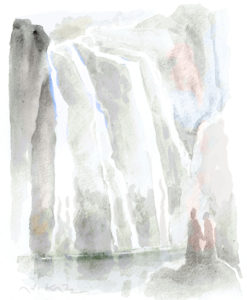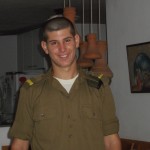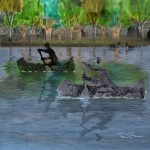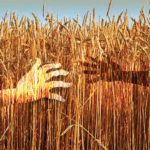Haim Watzman

On to the down-home bargain hotel in shabby-to-slummy Tiberias, where we will spend the long second weekend of Pesach. From our window we have a view, not of Lake Kinneret, but of the rubbish-filled yards of abandoned buildings up the street, and the lonely olive trees that dot the mountain slopes between the upper city’s housing-project neighborhoods.
The next morning, Thursday, the eve of the holiday, we continue north, as far north as we can go, to Metula. We take a right at the gate, then turn right again and again to reach the entrance to the Ayun Reserve. A stream of that name wells up a bit further north, in Marjayoun—I saw it three and a half decades ago, when I shuttled through the town time and again as a soldier serving unenthusiastically in Lebanon. When it crosses the Israeli border, it enters a narrow canyon and spills down a steep series of waterfalls, into the Hula Valley. Thirteen years ago the stream dried up, when Hezbollah diverted the source springs in the Lebanese town to irrigate the fields nearby. A few years ago, the Israel Nature and Parks Authority brought the stream back to life by piping in water from the Dan, a mightier stream to the southeast. Dan and Ayun, along with Hatzbani and Banyas, are the four headwaters of the Jordan, fed by melted snow from Mt. Hermon filtered through limestone strata laid down by primordial seas and pushed up by ancient cataclysms.
Seven years ago, on this holiday, our son died. Niot, our third headwater, was like a stream. He bubbled up, burbled, flowed over rapids, made all around him green and alive. Year round, year by year, for twenty years.
At the unassuming ticket booth in front of the gate to the reserve, we present our bereaved parent cards, which gain us free entry. We’re just in time for a guided tour, led by Tal, who looks as if she’s Niot’s age when his stream stopped flowing, but who is actually, it turns out, thirty-five. There’s only one other couple on the tour, a decade or so younger than we are, providing us with a quiet bubble among the loud families and school groups that we pass on our journey down.
We don’t tell our companions who we are. That is, we say we are from Jerusalem, and that (it stabs inside) we have four children. They are from Rehovot. We seek mutual acquaintances, but come up empty. We’ll see four waterfalls on our way down, Tal says, but one is hidden. A river issues from Eden to water the garden, and then it divides and becomes four branches. One has gone dry.
Suppose they had returned to Eden, Adam and Eve, after their son Abel died. Had God granted them a dispensation to visit, would it have been the same place they were exiled from? Would they have found comfort in paradise?
We have not come to the tiny paradise watered by the Ayun for solace. Nature offers none. But the red streak of a wallcreeper winging through the green ellipses of terebinth leaves is the essence of beauty, and beauty is beauty even as we mourn. Dragonflies, descendants of those once eyed by dinosaurs, hover and swoop unheeding of the memories within us. The eucalyptuses by the first waterfall, which we first see from above and then descend to along a narrow and crooked path, are being removed, Tal tells us, as they are Australian foreigners in this Mediterranean ecosystem, and poison anything that tries to grow below.
Grief, too, can poison all life around it, if you let it. I can’t deny that I have been tempted. Why should a devastated life not be lived in the midst of devastation? But it is the only life I have, and while our family may have a hole gaping within it, it is still a family. We were together for the first holiday weekend, which marked our last day with Niot. His siblings are spending the second weekend with the families of their spouses, or with friends, as is only fair. Rather than stay home with memories, we go north to see the four waterfalls, one of which can easily be passed unseen.
Past the second waterfall another spring wells up and joins the stream. An abandoned structure stands there, apparently a mill. Tal tells us of the Druze village that stood above during the eighteenth and nineteenth centuries. The land was not theirs, however. It belonged to a Christian, who sold it to Jews, and in 1896 the northernmost Jewish settlement in Palestine was founded here. There are wine presses and graves from Roman and Byzantine times.
I point out, along the path, an outcropping of conglomerate, a rock, as its name implies, formed from smaller pebbles cemented together by smaller grains. It forms in swiftly-flowing streams, but the stream is a couple of meters below us; it shows that in the past, when the river ran strong during the winter, its torrent covered the path we walk on. The stream gets turned off at night, Tal tells us, when the water piped from the Dan is used to irrigate the fields of Metula’s farmers. The stream we see is an artifice, a beautiful one, imposed on a bleak reality.
The third waterfall can be missed. As we continue along the path, it does not come into view, but sounds behind us, like a memory. When we turn to see it, we face backward, toward the past of the path along which we’ve walked. Just past the waterfall, the path curves around Metula’s cemetery, where we fill our water bottle.
We descend to the largest of the waterfalls, the Tanur, where families picnic and children splash. On the observation deck, spray from the fall wets us. One of our companions takes our picture, but because of the light reflecting off the curtain of water, the photograph shows us as dark shadows. Dark shadows in Eden.
As there are only four of us, Tal gives us a ride back up to Metula, where our rental car waits. The sun hangs over the Naftali Heights to the west. Our spirits are as high as waterfalls and as low as a canyon from our visit to this branch of the river of paradise. It’s the seventh anniversary of Niot’s funeral, and we have a holiday weekend ahead of us. Our elation is the rainbow in the mist of a waterfall that plummets into a chasm of unplumbable depth. One of our four streams has run dry. We pipe in water to keep it green.
^^^^^^^^^^^^^^^^^^^^^^^^^^^^^^^^^^^^^^^^^^^^^^^^^^^
Please consider a donation to The Niot Project, an educational program we have set up in Niot’s memory.
 Necessary Stories, a collection of twenty-four of the best of Haim Watzman’s short fiction, is dedicated to Niot and contains several pieces about mourning him. It is available as an e-book, paperback, and hardback on Amazon, and on all other on-line stores and select brick-and-mortar establishments. More information on South Jerusalem
Necessary Stories, a collection of twenty-four of the best of Haim Watzman’s short fiction, is dedicated to Niot and contains several pieces about mourning him. It is available as an e-book, paperback, and hardback on Amazon, and on all other on-line stores and select brick-and-mortar establishments. More information on South Jerusalem
Necessary Stories about Niot:
 Third Day of Spring
Third Day of Spring
Meditation: Planting flowers at my son’s grave.
 The Day of His Birth
The Day of His Birth
Meditation: On the death of my son.
 A Him to him
A Him to him
Meditation: A letter to Bach on the loss of my son.
 Other Nights
Other Nights
Meditation: The Seder, chamber music, and the death of my son.
 Fireflies
Fireflies
Meditation: Mourning my son, four years later
 Desertion
Desertion
Meditation: When a child dies, he becomes incessantly present.
 Grasping the Void
Grasping the Void
Meditation: Five years without my son






May his memory be for a blessing